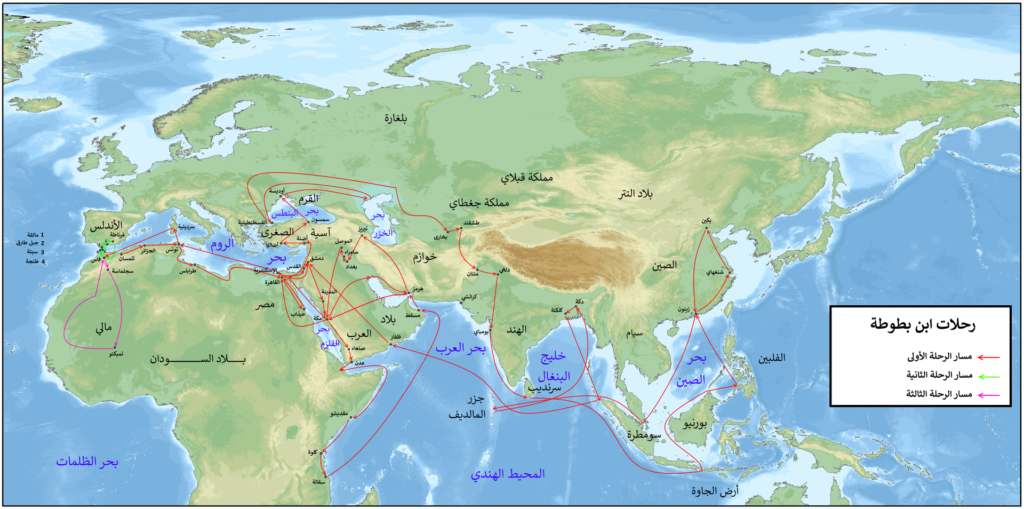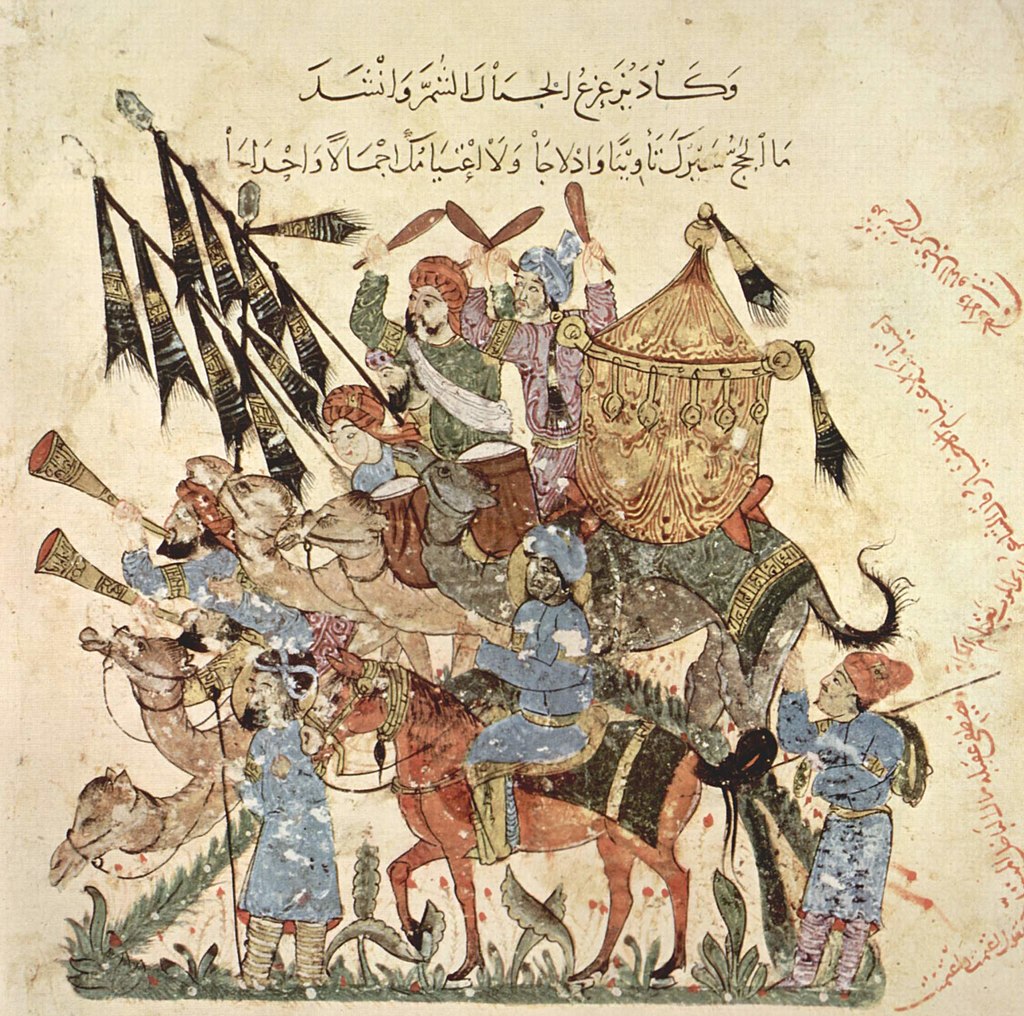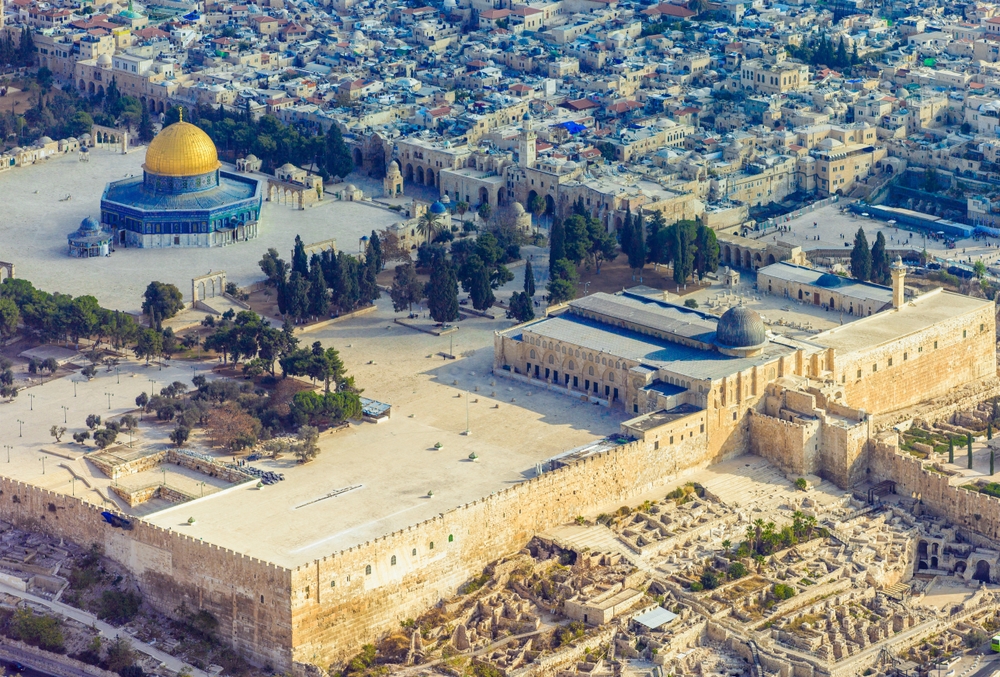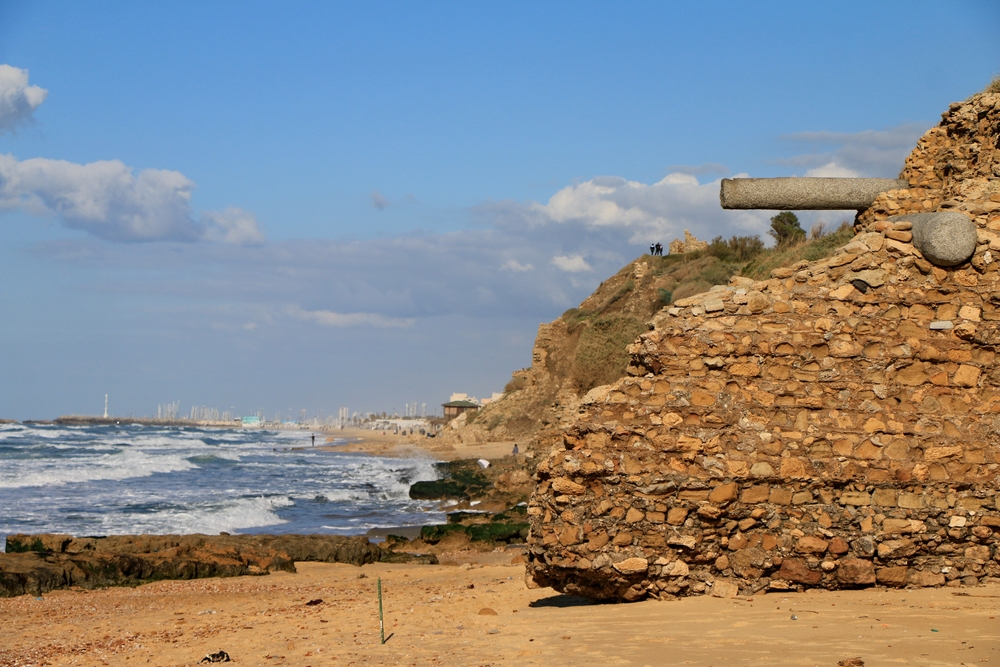Throughout history, the world has known many travellers who have depicted how the world was at the time and who have been credited with numerous discoveries, among them the Moroccan traveller “Ibn Battuta,” one of the most famous travellers in the world, who was born in 1304 CE in the city of Tangier, North Morocco, to an Amazigh family.
According to historical books, the name “Ibn Battuta” is derived from his mother’s name, who was called Fatimah. It was customary at that time to name children after their mothers, and this name was later corrupted to “Battuta” instead of Fatimah.
Returning to the books of the travellers, we find his description of his journey to Palestine, which has resurfaced in recent events in Gaza, during which the Israeli occupation destroyed many historical landmarks within the Gaza Strip, especially since the period in which Ibn Battuta travelled to Palestine was stable and not witnessing wars.
This brings us back in time, engraved in our memories, raising questions about the situation in Palestine in earlier periods of its history, especially during times of peace and security under Muslim rule. Did this land experience periods of prosperity and abundance? What was life like for people in its cities? And what were the impressions of travellers who visited it throughout the ages?
Who is the traveler Ibn Battuta?

He is Abu Abdullah Muhammad ibn Abdullah ibn Muhammad al-Lawati al-Tanji, known as Ibn Battuta, born on February 24, 1304, in the city of Tangier, and died in 1377. He was a traveller, historian, and judge from the Lawata tribe in far western Morocco, and he was given the title “Prince of Muslim Travelers.”
Ibn Battuta set out from Tangier in 725 AH and embarked on an exploratory journey that included the Maghreb, Egypt, Abyssinia, as well as Syria, the Hijaz, Tihama, Najd, and Iraq, along with Persia, Yemen, Oman, Bahrain, Turkistan, parts of India and China, Java, the lands of the Tatars, central Africa, and Andalusia. He also interacted with the kings and princes of those countries and used their gifts to facilitate his travels.
After his long journey, he returned to far western Morocco and settled in his homeland. He recorded his experiences in his book “The Gift of Observers Concerning the Wonders of Lands and the Marvels of Travels,” which was dictated by Muhammad bin Juzi al-Kalbi. Translations of the book spread in Portuguese, French, and English, as well as in German. He also mastered the Turkish and Persian languages.
His journey lasted for 27 years, and his tomb is located in the old city of Tangier. Cambridge University considered him the “Prince of Muslim Travelers” in its books and encyclopedias.
In his first journey, Ibn Battuta traversed many contemporary countries, from Algeria and Tunisia to Egypt and Sudan, then to Palestine, Syria, and finally to Mecca, as he was passionate about visiting the holy places and shrines of prophets and saints in the Islamic world, especially in Jerusalem, Hebron, Ashkelon, Tiberias, and other cities of Palestine.
Ibn Battuta remains one of the most important travellers in history, covering more than 75,000 miles, a distance not covered by any solo traveller before the steam age, after 450 years.
Ibn Battuta and his description of Gaza and Hebron

In the months of the year 1326 CE, Ibn Battuta arrived in Egypt, intending to perform the Hajj through the traditional route of the Moroccans. He travelled from the Nile to Upper Egypt, then penetrated the Eastern Desert towards the Red Sea.
As he progressed on his journey, he was forced to return north towards Cairo due to the wars between the Buja and the Mamluks ruling Egypt at that time. He then headed to Bilbays in Sharqia and stayed there in the month of Sha’ban of that year.
Ibn Battuta crossed the Sinai Desert towards the north towards El-Arish, and from there to Gaza, which he described as follows: “The first of the Levantine lands after Egypt, spacious, with many buildings, beautiful markets, and many mosques without walls around them.”
Ibn Battuta admired the largest mosques in Gaza, especially the Jauli Mosque built by Prince Alam al-Din Singar al-Jauli, who was keen to rebuild the city and build its schools and mosques. He noted that the Al-Salim family held a high cultural position in Gaza and listed the names of some of its scholars.
After visiting Gaza, Ibn Battuta moved to the city of Hebron, where he described the Ibrahim Mosque and the Cave of the Patriarchs, which contains the tombs of the prophets, including the tomb of Yusuf (Joseph), peace be upon him, and the soil of Lut. His journey revealed to us the important religious and cultural sites in Palestine and Egypt during that period.
Description of the West Bank
After Gaza, Ibn Battuta headed to Hebron, as Ibn Battuta began his journey towards the Dead Sea, which he called the “Lake of Lut.” He described its extreme salinity, mentioning the existence of a mosque called “Al-Yaqeen Mosque”
From the village of Yaqin in Bani Na’im east of Hebron, where the remains of the mosque are still standing, Ibn Battuta set off towards Jerusalem. On his way there, he visited Bethlehem, where the site of the birth of Jesus, peace be upon him, is located. He documented his visit to the site and to the palm tree that is said to be the trunk of the palm tree under which Mary was enlightened upon the birth of Jesus. He spoke of many buildings surrounding this site and the great respect shown by Christians to it.
This respect allows its worshipers and visitors the freedom to move around and be hosted by the members of their community without any taxes, as Ibn Battuta mentioned in his visit to the Church of the Resurrection later on, despite the fierce Crusades that lasted for two centuries in those regions, which were completely ended by the Mamluks after the efforts of Salah al-Din al-Ayyubi.
The arrival of Ibn Battuta to Jerusalem

Upon his arrival in Jerusalem, the Moroccan traveller Ibn Battuta expressed his great admiration for the holy city and the sight of the Al-Aqsa Mosque and the Dome of the Rock Mosque. He offered high praise for the beauty and magnificence of the Al-Aqsa Mosque, saying: “The Holy Mosque, which is one of the marvellous, delightful, and most beautiful mosques, it is said that there is no mosque on earth larger than it.”
No one should be surprised by this description for two main reasons: first, because he had not yet visited the Haram Mosque in Mecca until that moment, and second because the Haram Mosque in Mecca itself was not in the current area it is today.
Ibn Battuta rejoiced in the beauty of the holy city and detailed it, focusing on sacred places such as the Al-Aqsa Mosque and the Dome of the Rock Mosque. His journey also included getting to know the Moroccans, who chose Jerusalem as a place of residence that is still vibrant under their name and door in Jerusalem.
He also mentioned some Andalusians who lived in the city and mentioned the Maliki scholar and the honourable Khanqah sheikh, Abu Abdullah Muhammad ibn Mathbat al-Gharnati, who was a resident of Jerusalem. He also mentioned some scholars and elders of Jerusalem, including some of the Al-Salim lords in Gaza.
Return to Palestine and the city of Tiberias

When Ibn Battuta headed to the city of Tyre in the north, he returned to Palestine to explore the city of Tiberias. He described the city as once being a great city, but it has become less significant and smaller in size. However, Ibn Battuta’s interest was directed towards visiting mosques, prophets’ shrines, and saints’ sites and acquiring knowledge of their histories.
Return to Palestine and the city of Tiberias In Tiberias, he visited a mosque known as the Mosque of the Prophets, which includes the tombs of the Prophet Shuayb, peace be upon him, his daughter, the wife of the Prophet Moses, peace be upon him, the tomb of the Prophet Solomon, peace be upon him, and the tombs of Judah and Rubil. He went to the cave where the Prophet Joseph, peace be upon him, was thrown and found that water springs from this cave, from which he drank rainwater that accumulates there, and the guardian of the place told him that water also springs from the cave.
Ibn Battuta praised the water springs in Tiberias, mentioning that some of them were hot sulphur springs known to the Romans since ancient times. The inhabitants of the city took advantage of this blessing and established amazing baths, divided into sections for men and women, with extremely hot water. He also mentioned the famous lake in the city, which was of large dimensions.
Ibn Battuta’s journey to Palestine is considered one of the oldest journeys describing the cities during that period, and the way people lived during that period, indicating that Palestine was a safe country if not for the Zionist intervention and its occupation of Palestinian territories in the mid-twentieth century due to the British mandate in it.
Sunna Files Free Newsletter - اشترك في جريدتنا المجانية
Stay updated with our latest reports, news, designs, and more by subscribing to our newsletter! Delivered straight to your inbox twice a month, our newsletter keeps you in the loop with the most important updates from our website











